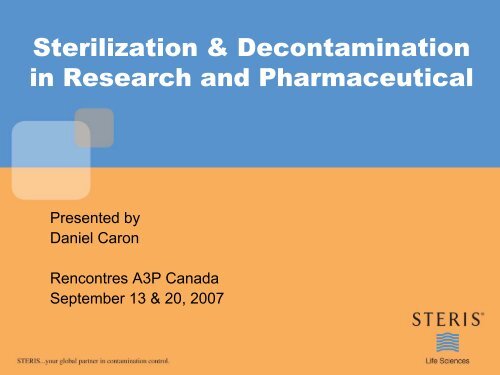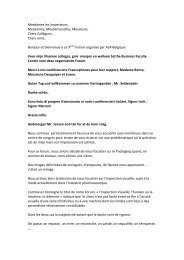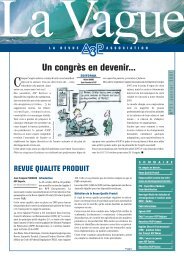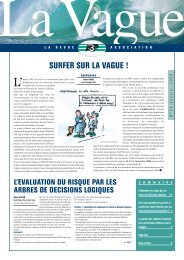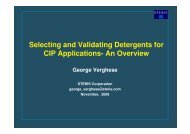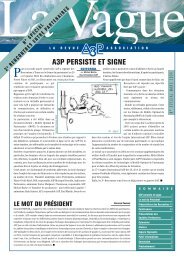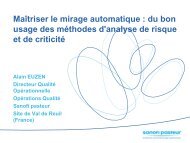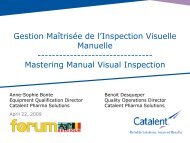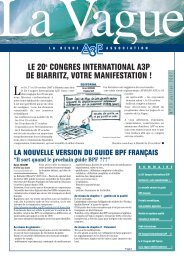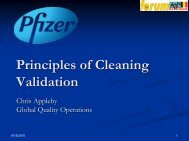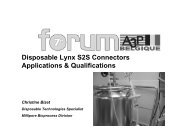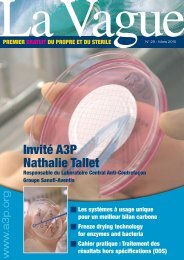The Steam Sterilization Cycle - A3P
The Steam Sterilization Cycle - A3P
The Steam Sterilization Cycle - A3P
You also want an ePaper? Increase the reach of your titles
YUMPU automatically turns print PDFs into web optimized ePapers that Google loves.
<strong>Sterilization</strong> & Decontamination<br />
in Research and Pharmaceutical<br />
Presented by<br />
Daniel Caron<br />
Rencontres <strong>A3P</strong> Canada<br />
September 13 & 20, 2007
Principles of <strong>Steam</strong> <strong>Sterilization</strong><br />
<strong>Steam</strong> is the ideal sterilant for items that can<br />
withstand moisture and high temperatures<br />
because it is:<br />
• nontoxic<br />
• readily available<br />
• fairly easy to control
Principles of <strong>Steam</strong> <strong>Sterilization</strong><br />
<strong>Steam</strong> is Water in the Vapor State<br />
<strong>Steam</strong> Heats by Condensing and Giving Up Energy<br />
• 6.8X More Energy Required<br />
– Boiling from liquid to Vapor at 212F than heating from 70F-<br />
212F<br />
• By-product is Condensation<br />
– Remains on product<br />
– Rolls off
Principles of <strong>Steam</strong> <strong>Sterilization</strong><br />
Three factors are critical to assure successful<br />
steam sterilization:<br />
• time<br />
• temperature<br />
• moisture
Principles of <strong>Steam</strong> <strong>Sterilization</strong><br />
TIME<br />
All organisms do not die at the same time. <strong>The</strong> number of<br />
survivors is usually plotted on a semi-logarithmic scale. A<br />
straight line survivor curve usually results.
Microbial Death Rate Curve that<br />
Illustrates Concept of D-ValueD<br />
Number of Survivors<br />
10,000<br />
Log Number of Survivors<br />
4<br />
1,000<br />
3<br />
100<br />
2<br />
10<br />
1<br />
1<br />
0.1<br />
D-Value<br />
D-Value is the time to reduce<br />
the microbial population by<br />
90% or 1 log<br />
0<br />
-1<br />
0.01<br />
0 1 2 3 4 5 6 7 8 9 10 11 12<br />
Exposure Time (Minutes)<br />
-2
Principles of <strong>Steam</strong> <strong>Sterilization</strong><br />
Temperature<br />
•<strong>The</strong> second critical factor in steam sterilization is the<br />
temperature of the saturated steam.<br />
•Increasing temperature dramatically reduces the time<br />
needed to achieve sterilization.
Time to Achieve Equivalent Microbial Lethality at<br />
Different Exposure Temperatures<br />
Population 10E6, D value 2 minutes<br />
285° F (140° C)<br />
( .13 Minutes )<br />
270° F (132° C)<br />
( 0.9 Minutes )<br />
250° F (121° C)<br />
12 Minutes<br />
212° F (100° C)<br />
80 Hours<br />
200° F (93° C)<br />
321 Hours<br />
176° F (80° C)<br />
643 Hours<br />
10 20 30 40 50 60 100 300 500 700<br />
MINUTES<br />
HOURS
Principles of <strong>Steam</strong> <strong>Sterilization</strong><br />
Moisture<br />
•<strong>Steam</strong> denatures or coagulates proteins.<br />
•Dry heat is an oxidation process with different kinetics - it<br />
requires much higher temperatures and longer exposure times.<br />
•B. stearothermophilus spores - killed in 12-15 minutes at 121°C<br />
(250 °F) when saturated steam is used<br />
•more than 6 hours are required to dry heat at 121°C.
<strong>The</strong> following illustration shows the basic<br />
components of a typical prevacuum steam sterilizer:<br />
Chamber<br />
Safety<br />
Valve<br />
Air<br />
Filter<br />
Jacket<br />
Safety<br />
Valve<br />
Jacket / Chamber<br />
<strong>Steam</strong> Supply<br />
Pressure<br />
Regulator<br />
PC<br />
Jacket<br />
<strong>Steam</strong><br />
Supply<br />
Chamber<br />
Temperature<br />
Sensor<br />
<strong>Steam</strong> Supply Jacket<br />
Bleed<br />
Valve<br />
Jacket<br />
Trap<br />
Chamber<br />
Trap<br />
Vacuum<br />
System<br />
To Waste
Principles of <strong>Steam</strong> <strong>Sterilization</strong><br />
<strong>The</strong> <strong>Steam</strong> <strong>Sterilization</strong> <strong>Cycle</strong><br />
A steam sterilization cycle consists of three<br />
phases:<br />
– Heating (pre-conditioning) phase<br />
– <strong>Sterilization</strong> (exposure) phase<br />
– Cool-down (post conditioning) phase
<strong>The</strong> <strong>Steam</strong> <strong>Sterilization</strong> <strong>Cycle</strong><br />
Heating (pre-conditioning) phase -<br />
<strong>Steam</strong> enters the sterilizer chamber and air<br />
is removed by either:<br />
gravity displacement<br />
mechanically (prevacuum)
<strong>The</strong> <strong>Steam</strong> <strong>Sterilization</strong> <strong>Cycle</strong><br />
<strong>Sterilization</strong> (exposure) phase -<br />
Load is exposed to steam at a set temperature<br />
(measured and controlled by a temperature<br />
sensor in the drain line or product) for a set<br />
time.
<strong>The</strong> <strong>Steam</strong> <strong>Sterilization</strong> <strong>Cycle</strong><br />
Cool-down (post-conditioning) phase -<br />
Sterilizer chamber is exhausted to atmospheric<br />
pressure followed by circulating air through the<br />
chamber or by drawing vacuum. Jacket heat<br />
may or may not be maintained during the<br />
drying phase.
Basic Gravity and Prevac <strong>Cycle</strong>s<br />
40<br />
30<br />
20<br />
10<br />
0<br />
Pre-Vac<br />
Gravity<br />
-10<br />
-20<br />
-30<br />
9
Basic Gravity <strong>Cycle</strong><br />
Applications:<br />
• Empty glassware<br />
• Instruments<br />
Basic Gravity <strong>Cycle</strong><br />
• Open, empty pans, vats, carboys
Basic Liquid <strong>Cycle</strong><br />
(Modified gravity cycle)<br />
Generally used to process<br />
• Media/Liquids in open containers<br />
– Water<br />
– TSB<br />
– TSA<br />
• Filled bottles / tubes with loose caps<br />
• Generally at 121 o C
Basic Gravity <strong>Cycle</strong><br />
Pre-conditioning and Exposure<br />
Two Methods of Controlling the <strong>Cycle</strong><br />
• Control by Temperature Probe in Drain<br />
– Timed<br />
• Control using Probe in Product<br />
– F o
Basic Gravity <strong>Cycle</strong><br />
Pre-conditioning and Exposure<br />
May use F o<br />
load probe in liquid loads if it is<br />
available in the sterilizer<br />
• Advantages<br />
– produces desired lethality<br />
– minimal effect on product<br />
– optimizes the exposure period<br />
Can use time at temperature if probes are not<br />
available (overkill method)
What is F 0<br />
F0 as a Function of Temperature<br />
Lethality Curve<br />
1.545<br />
123 °C<br />
1.227<br />
122 °C<br />
1.00<br />
121.1 °C<br />
F 0 Value<br />
.50<br />
118.1 °C<br />
.245 115 °C<br />
.008<br />
110 °C<br />
Fo Calculation<br />
*Reference Temperature 121.1°C<br />
Z - Value = 10 °C
Gravity <strong>Cycle</strong><br />
Post- conditioning<br />
Liquid <strong>Cycle</strong>s are returned to atmospheric pressure<br />
slowly to<br />
• Prevent boil-over<br />
• Prevent liquid loss<br />
Rate of slow exhaust depends on<br />
• Volume of liquid per flask / tube<br />
• Total load capacity<br />
• If there is a jacket cooling process built into the sterilizer
Prevac or Pulsing Vac <strong>Cycle</strong>s<br />
Generally used to process dry goods<br />
• articles in open trays<br />
• porous goods such as textiles<br />
• open, unfilled glassware/plastic bottles<br />
• rubber stoppers<br />
• filter cartridges<br />
• Disc filters
Prevac <strong>Cycle</strong> Loads<br />
Metal articles<br />
Porous goods (textiles)<br />
Glassware (open)<br />
Glassware in pouches<br />
Plastics (open)<br />
Plastics in pouches<br />
Rubber stoppers<br />
Filter cartridges<br />
Disk filters<br />
2.1.3
Prevac <strong>Cycle</strong><br />
Pre-conditioning<br />
Number and depth of vacuums during pre-conditioning<br />
can be user selectable<br />
• based on degree of difficulty to penetrate product with steam<br />
– Tygon tubing may take several pulses/vacs to penetrate to<br />
center of tube<br />
– Long lengths may require deeper vacuum<br />
– Large metal items may require several pulses to heat
Prevac <strong>Cycle</strong>s<br />
Product Constraints<br />
Ability of the product to withstand ;<br />
• vacuums<br />
• pressure / vacuum rates<br />
– Peel pouches may burst<br />
– Covers may be blown off of covered pipe ends<br />
May need to control rates if available on sterilizer
Prevac <strong>Cycle</strong><br />
Exposure Phase<br />
• Timed<br />
• Based on drain line temperatures<br />
• Generally at 121 o C but could be at 132 o C<br />
• Overkill method employed
Post-conditioning phase<br />
Single deep vacuum, hold<br />
Used to dry the load<br />
Basic cycle draws a single deep vacuum and holds<br />
Hold time varies<br />
• may be 20-45 minutes or longer<br />
• Time depends on<br />
– material that comprises load<br />
– packaging<br />
– level of dryness required
Post-conditioning<br />
Pulsing Vac <strong>Cycle</strong><br />
Pulls vacuum with alternating pressurization with<br />
air<br />
Used for peel pouched items, items with low<br />
specific heat (rubber goods)<br />
• May be unheated or optional heated
Gravity <strong>Cycle</strong>s<br />
30<br />
25<br />
20<br />
15<br />
10<br />
5<br />
0<br />
-5<br />
-10<br />
-15<br />
-20<br />
-25<br />
GRAVITY DISPLACEMENT<br />
>Provided on both gravity and prevacuum sterilizers<br />
>Operates on the downward air displacement air-removal principle.<br />
>Used for sterilizing nonporous heat and moisture stable goods at 250 or 270°F<br />
(121 or 132°C).<br />
Gravity
Isothermal <strong>Cycle</strong>s<br />
4<br />
3.5<br />
3<br />
2.5<br />
2<br />
1.5<br />
1<br />
0.5<br />
0<br />
Isothermal<br />
ISOTHERMAL CYCLE- Optional cycle<br />
>Designed for low temperature sterilization of heat sensitive and heat coagulable materials.<br />
>Used for pasteurization, melting agar, inspissation (increase in viscosity by dehydration of highprotein<br />
containing media), or fractional sterilization (Tyndallization)<br />
>Temperatures are controlled at 78C(172F), 88C (190F), and 104C(219F)
Liquid <strong>Cycle</strong>s<br />
16<br />
14<br />
12<br />
10<br />
8<br />
6<br />
4<br />
2<br />
0<br />
Liquids<br />
LIQUID CYCLE- Modified Gravity <strong>Cycle</strong><br />
>Provided on both gravity and prevacuum sterilizers<br />
>Used for sterilizing liquids, in flasks or test tubes with vented closures,<br />
at 250°F (121°C).<br />
>Optimal Solution Cooling is on Century Units
Prevac <strong>Cycle</strong>s<br />
40<br />
30<br />
20<br />
10<br />
0<br />
Pre-Vac<br />
-10<br />
-20<br />
-30<br />
PREVACUUM<br />
>Available only on prevacuum sterilizers<br />
>Employs a mechanical air-removal system<br />
>For efficient, high-volume processing of porous heat and<br />
moisture stable materials, such as fabrics, wrapped hard goods,<br />
and container systems at 250 or 270°F (121°C or 132°C).
Decontamination <strong>Cycle</strong>s<br />
Optional cycle designed to decontaminate all effluents from the sterilizer<br />
chamber prior to discharge to drain<br />
During purge, pre-steam pulses, and heat-up phases, steam is<br />
admitted through the drain port (located on the sterilizer chamber floor).<br />
Helps to heat any condensate on the chamber floor to sterilizing<br />
temperatures.<br />
Potentially contaminated air is pushed upward and discharged<br />
through the vent in the top of the chamber.<br />
Gaseous exhaust filtered through a 0.2 micron (0.2 micrometer) bacterial<br />
retentive filter before exiting to the sterilizer vacuum system, building drain<br />
system, and surrounding environment.
Decontamination <strong>Cycle</strong><br />
<strong>The</strong> temperature is monitored and controlled using a<br />
temperature probe located after the bacterial retentive filter<br />
housing.<br />
<strong>The</strong> bacterial retentive filter is also sterilized during the<br />
exposure phase.<br />
After the exposure phase the decontaminated condensate<br />
that has accumulated in the drain line and chamber floor is<br />
discharged via the drain port located on the chamber floor.<br />
All liquid effluents are decontaminated prior to discharge to<br />
drain.
Standard <strong>Steam</strong> Flow
Decontamination <strong>Cycle</strong>s<br />
DECONTAMINATION (EFFLUENT DECONTAMINATION) CYCLE
Decontamination <strong>Cycle</strong>s
LABORATORY CYCLES<br />
Preconditioning Exposure Postconditioning<br />
Gravity Purge, Heat –up Timed Vacuum Dry<br />
Prevac<br />
Purge, Prevac<br />
Pulses, Heat-up<br />
Timed<br />
Vacuum Dry<br />
Liquids Purge, Heat-up Timed<br />
F0 Optional<br />
Slow Exhaust<br />
Isothermal Purge, Heat-up Timed Slow Exhaust<br />
Decontamination<br />
Purge, Prevac<br />
Pulses, Heat-up<br />
Timed<br />
Vacuum Dry
B Process <strong>Cycle</strong>s<br />
>General purpose steam sterilization cycle applicable for all dry goods and porous loads.<br />
>Suitable products include filters, equipment parts, instruments, textiles, and rubber goods.<br />
>Primarily used for production, clean room supplies and utensils, and production support.<br />
>Features a preconditioning air removal phase using vacuum and steam pulses.<br />
>Drying can be accomplished by deep vacuum, vacuum pulsing, or fast exhaust.
B Process <strong>Cycle</strong>s<br />
Continued<br />
>General purpose steam sterilization cycle applicable for liquids in open / vented containers<br />
e.g., culture media with vented closures.<br />
>May be used for microbial decontamination of liquids in vented/open containers or vented<br />
red/orange bags.<br />
>Utilizes a forced air preconditioning and a user programmable rated slow exhaust.<br />
><strong>Steam</strong>-to-jacket is turned off during slow exhaust.
CA Process <strong>Cycle</strong>s<br />
>Designed for liquid products in vented or sealed containers.<br />
>Primarily used for production, media preparation, and R&D purposes when liquids are in open<br />
containers or cooling time is less critical.<br />
>Employs forced air removal during preconditioning.<br />
>No circulating water in the sterilizer jacket is used.<br />
>Maintains sterile air overpressure during the cooling phase to cool the load and prevent the<br />
product from boiling.
C Process <strong>Cycle</strong>s<br />
>Designed for liquid products in vented or sealed containers.<br />
>Primarily used for production, media preparation, and R&D purposes when liquids are in<br />
open containers or cooling time is less critical.<br />
>Employs forced air removal during preconditioning and indirect cooling by circulating water<br />
in the sterilizer jacket.<br />
>Maintains sterile air overpressure during the cooling phase to cool the load and prevent the<br />
product from boiling.
CF Process <strong>Cycle</strong>s<br />
>Designed for liquid products (LVPs or SVPs) in vented or sealed containers.<br />
>Primarily used for production, media preparation, and R&D purposes when liquids are in open<br />
containers or cooling time is less critical.<br />
>Employs forced air removal during preconditioning and indirect cooling by circulating<br />
water in the sterilizer jacket.<br />
>Maintains sterile air overpressure during the cooling phase to cool the load and prevent the<br />
product from boiling.<br />
>A fan is present in the sterilizer chamber to assist in cooling the product during post<br />
conditioning.<br />
><strong>The</strong> circulated air with fan and jacket cooling process significantly reduces the cycle time by<br />
approximately 50% over a jacket cooling process, depending on the application.
<strong>Steam</strong>-Air-Mixture (A/C)<br />
><strong>Cycle</strong> designed for terminal sterilization of liquids in plastic or glass containers (e.g. pouches,<br />
bottles, LVPs, SVPs and blister packs) that must be dry at the end of the cycle.<br />
><strong>The</strong> cycle employs an over pressurized air/steam mixture to sterilize.<br />
>Counter pressure is maintained based on the product temperature through the entire cycle.<br />
>Cooling is performed by fan-circulated air, cooled by indirect jacket cooling.<br />
>Allows immediate post-cycle product processing (e.g. labeling and packaging).
<strong>Steam</strong>-Air-Mixture (A/C)
Superheated Water (RP)<br />
>Designed for terminal sterilization of liquids in plastic or glass containers (e.g. pouches, bottles,<br />
and blister packs).<br />
>Employs an over pressurized water spray to sterilize; No pure steam is required.<br />
>Air counter pressure is employed throughout the entire cycle based on the product temperature.<br />
>Extremely efficient cooling time.
RP Process <strong>Cycle</strong>s
G Process <strong>Cycle</strong>s<br />
>Designed for terminal sterilization of liquids in glass containers (vials, bottles).<br />
>For non-vented containers only.<br />
>Employs a purified water spray during cooling only.<br />
>Air counter pressure is also employed during the cooling based on the product temperature.
GΔT Process <strong>Cycle</strong>s<br />
>Designed for terminal sterilization of liquids in glass containers (vials, bottles).<br />
>For non-vented containers only.<br />
>Employs a temperature controlled purified water spray during cooling only.<br />
>Air counter pressure is also employed during the cooling based on the product temperature.<br />
><strong>The</strong> cooling time, delta and final load temperature are configurable to protect the load from<br />
thermal shock.
Process <strong>Cycle</strong>s<br />
Products to Sterilize <strong>Cycle</strong> End Support Air<br />
Media Precond. Exposure Postcond Cooling Media<br />
Open containers,<br />
vented flasks, textiles,<br />
components, utensils<br />
Open / vented containers,<br />
sealed bottles<br />
Open / vented containers,<br />
sealed bottles<br />
Open / vented containers,<br />
sealed bottles<br />
B DRY <strong>Steam</strong> <strong>Steam</strong>-to-jacket off;<br />
Heat loss by conduction<br />
CA DRY <strong>Steam</strong> X<br />
<strong>Steam</strong>-to-jacket off;<br />
Air overpressure<br />
C DRY <strong>Steam</strong> X<br />
Air overpressure/<br />
Jacket water<br />
CF DRY <strong>Steam</strong> X<br />
Air circ./ Jacket water/<br />
Fan on, during cooling<br />
only<br />
Sealed glass bottles G WET <strong>Steam</strong> X<br />
Water/jacket water/ Air<br />
overpressure<br />
Sealed glass fragile bottles GΔT WET <strong>Steam</strong> X<br />
Water temp, controlled /<br />
jacket water/ Air circ<br />
Sealed glass or Flexible containers<br />
E.g. plastic bags, blisters, syringes,<br />
containing liquids<br />
Sealed glass or Flexible containers;<br />
E.g. plastic bags, blisters, etc.<br />
A/C DRY <strong>Steam</strong> X X X<br />
Air / Jacket water/ Fan<br />
on during entire cycle<br />
RP WET Water X X X<br />
Water/ Air circ./ Jacket<br />
water
<strong>Cycle</strong>s for Solutions<br />
CYCLE TYPE<br />
STERILIZING<br />
MEDIA<br />
PRE-<br />
CONDITIONING<br />
LOAD STATUS AT END OF<br />
CYCLE<br />
SPEED OF COOLING<br />
B PROCESS<br />
WITH SLOW<br />
EXHAUST WITH<br />
RATES<br />
STEAM<br />
FORCED AIR;<br />
WITH OR<br />
WITHOUT RATES<br />
DRY EXTERNALLY AND<br />
APPROXIMATELY AT BOILING<br />
TEMPERATURE<br />
SLOW<br />
CA Process<br />
STEAM<br />
FORCED AIR;<br />
WITH OR<br />
WITHOUT RATES<br />
RELATIVELY DRY EXTERNALLY<br />
AND AT COOLING TEMPERATURE<br />
SET POINT (VACUUM DRYING<br />
MAY BE ADDED AFTER COOLING)<br />
SLOWER THAN C PROCESS, BUT<br />
FASTER THAN B PROCESS<br />
C Process<br />
STEAM<br />
FORCED AIR;<br />
WITH OR<br />
WITHOUT RATES<br />
RELATIVELY DRY EXTERNALLY<br />
AND AT COOLING TEMPERATURE<br />
SET POINT (VACUUM DRYING<br />
MAY BE ADDED AFTER COOLING)<br />
MODERATE<br />
CF Process<br />
STEAM<br />
FORCED AIR;<br />
WITH OR<br />
WITHOUT RATES<br />
DRY EXTERNALLY AND AT<br />
COOLING TEMPERATURE SET<br />
POINT (VACUUM DRYING MAY BE<br />
ADDED AFTER COOLING)<br />
MODERATELY FAST<br />
(FASTER THAN C PROCESS,<br />
BECAUSE OF FAN)
<strong>Cycle</strong>s for Solutions<br />
Continued<br />
CYCLE TYPE<br />
STERILIZING<br />
MEDIA<br />
PRE-CONDITIONING LOAD STATUS AT END OF CYCLE SPEED OF COOLING<br />
G<br />
STEAM<br />
FORCED AIR; WITH<br />
OR WITHOUT RATES<br />
WET, AND AT COOLING<br />
TEMPERATURE SET POINT<br />
(VACUUM DRYING MAY BE ADDED<br />
AFTER COOLING)<br />
MODERATE<br />
GΔT<br />
STEAM<br />
FORCED AIR; WITH<br />
OR WITHOUT RATES<br />
WET, AND AT COOLING<br />
TEMPERATURE SET POINT<br />
(VACUUM DRYING MAY BE ADDED<br />
AFTER COOLING)<br />
MODERATE; MORE<br />
CONTROLABLE<br />
THAN<br />
G PROCESS<br />
A/C<br />
STEAM (MIXED BY<br />
FAN WITH<br />
STERILE AIR<br />
COUNTER-<br />
PRESSURE)<br />
AC HEATING (STEAM<br />
AND STERILE AIR<br />
COUNTER-<br />
PRESSURE IN<br />
CHAMBER w/ FAN)<br />
DRY EXTERNALLY AND AT<br />
COOLING TEMPERATURE SET<br />
POINT; READY FOR LABELING OR<br />
PACKAGING<br />
MODERATELY FAST<br />
RP<br />
STERILE<br />
SUPERHEATED<br />
WATER (with<br />
STERILE AIR<br />
COUNTER-<br />
PRESSURE)<br />
STERILE<br />
SUPERHEATED<br />
WATER w/ STERILE<br />
AIR COUNTER-<br />
PRESSURE<br />
WET EXTERNALLY AND AT<br />
COOLING TEMPERATURE SET<br />
POINT<br />
MODERATELY FAST
Common Problems and<br />
Misconceptions About <strong>Steam</strong><br />
<strong>Sterilization</strong>
Common Problems<br />
Possible sources of<br />
air in chamber:<br />
Air is generally a deterrent to sterilization<br />
PACK<br />
STERILIZER CHAMBER<br />
AIR POCKET<br />
AIR<br />
‣Leak (during vacuum)<br />
in piping or door gasket<br />
‣Insufficient prevacuum<br />
‣Air entrained in steam<br />
STEAM<br />
+ AIR<br />
STEAM<br />
+ AIR<br />
SPORES<br />
STERILIZER DRAIN
Common Problems<br />
<strong>Steam</strong> Quality Issues<br />
Wet <strong>Steam</strong><br />
Wet steam is undesirable - it has<br />
less energy than dry steam and<br />
it can cause wet loads<br />
STERILIZER CHAMBER<br />
PACK<br />
Water Droplets<br />
•<strong>The</strong> packaging used for<br />
sterile products prevents recontamination<br />
when dry, but<br />
its bacterial retentive<br />
properties will be adversely<br />
affected by moisture.<br />
•Wet loads can be<br />
considered to be nonsterile.<br />
•Causes - Wet steam may<br />
be caused by excessive<br />
pressure drops on the boiler<br />
due to high demands.<br />
STEAM<br />
+ Water<br />
STERILIZER DRAIN<br />
STEAM<br />
+ Water
Misconception<br />
Assumption: Everything Can Be Sterilized<br />
Facts<br />
• Closed valves on containers do not permit<br />
steam penetration. Open all valves<br />
• O-rings and seals retard steam penetration. May<br />
need to remove o-rings or extend processing<br />
times<br />
• Upright, empty containers are difficult to remove<br />
air from with a gravity cycle
Test Tubes in Rigid Container<br />
Fact: Solid bottom<br />
containers retard steam<br />
penetration<br />
• Bottom set of tubes in<br />
container<br />
• Top set of tubes above<br />
container
Effects of Rigid Bottom Container<br />
Temperature<br />
° F<br />
260<br />
240<br />
220<br />
200<br />
180<br />
160<br />
140<br />
120<br />
100<br />
80<br />
60<br />
40<br />
20<br />
Top Test Tube Rack<br />
Bottom Test Tube Rack<br />
0 2 4 6 8 10 12 14 16 18 20<br />
Time (Minutes)
Misconception<br />
Assumption: Exposure Time for a Liquid <strong>Cycle</strong><br />
Means That the Product is at Temperature for that<br />
Period<br />
Fact: Exposure time must account for product comeup<br />
and desired time at temperature
Come-up Rates for Two Different Flask<br />
Sizes<br />
140<br />
120<br />
100<br />
80<br />
60<br />
40<br />
Chamber Drain<br />
Media Load 1<br />
Media Load 2<br />
20<br />
0
Misconception<br />
Assumption: <strong>The</strong> attainment of 121.1 0 C is a<br />
significant requirement to sterilize.<br />
Fact: <strong>The</strong> objective of steam sterilization is to deliver<br />
lethality. F 0<br />
accumulates at all spore killing<br />
temperatures although it is slower at lower<br />
temperatures.
Misconception<br />
Assumption: A steady state temperature distribution<br />
range of +/- .5 0 C is necessary for all loads.<br />
Fact: Desirable for terminal sterilization in final<br />
containers. Not required for sterilization of production<br />
equipment. Distributions of 1 0 C to 2 0 C are acceptable
Misconception<br />
Assumption: Fixed load patterns are required for<br />
proper sterilization<br />
Fact: It is not as much the location of the items, but<br />
the material makeup, wrapping, mass, loading<br />
procedures and orientation of the load that define<br />
“difficult-to-sterilize locations”
QUESTIONS ?
MERCI !


